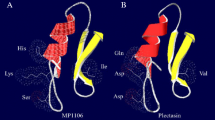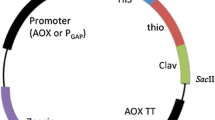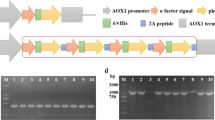Abstract
NZ2114, a new variant of plectasin, was overexpressed in Pichia pastoris X-33 via pPICZαA for the first time. The total secreted protein of fermentation supernatant reached 2,390 mg/l (29 °C) and 2,310 mg/l (25 °C), and the recombinant NZ2114 (rNZ2114) reached 860 mg/l (29 °C) and 1,309 mg/l (25 °C) at 96 h induction in a 5-l fermentor, respectively.The rNZ2114 was purified by cation exchange chromatography, and its yield was 583 mg/l with 94.8 % purity. The minimal inhibitory concentration (MIC) of rNZ2114 to four ATCC strains of Staphyloccocus aureus was evaluated from 0.028 to 0.90 μM. Meanwhile, it showed potent activity (0.11–0.90 μM) to 20 clinical isolates of MRSA. The rNZ2114 killed over 99.9 % of tested S. aureus (ATCC 25923 and ATCC 43300) in Mueller-Hinton medium within 6 h when treated with 4 × MIC. The postantibiotic effect of rNZ2114 to S. aureus ATCC 25923 and ATCC 43300 was 18.6–45.6 and 1.7–3.5 h under 1×, 2×, and 4× MIC, respectively. The fractional inhibitory concentration index (FICI) indicated a synergistic effect between rNZ2114 and kanamycin, streptomycin, and vancomycin against S. aureus ATCC 25923 (FICI = 0.125), and additivity between rNZ2114 and ampicillin, spectinomycin (FICI = 0.625), respectively. To S. aureus ATCC 43300 [methicillin-resistant S. aureus (MRSA)], rNZ2114 showed a synergistic effect (FICI = 0.125–0.3125) with kanamycin, ampicillin, streptomycin, and vancomycin, and antagonism with spectinomycin (FICI = 8.0625). The rNZ2114 caused only less than 0.1 % hemolytic activity in the concentration of 128 μg/ml, and showed a good thermostability from 20 to 80 °C. In addition, it exhibited the highest activity at pH 8.0. These results suggested that large-scale production of NZ2114 is feasible using the P. pastoris expression system, and it could be a new potential antimicrobial agent for the prevention and treatment of S. aureus especially for MRSA infections.






Similar content being viewed by others
References
Andes D, Craig W, Nielsen LA, Kristensen HH (2009) In vivo pharmacodynamic characterization of a novel plectasin antibiotic, NZ2114, in a murine infection model. Antimicrob Agents Chemother 53:3003–3009
Archer GL, Scott J (1991) Conjugative transfer genes in Staphylococcal isolates from the United States. Antimicrob Agents Chemother 35:2500–2504
Brinch KS, Tulkens PM, Van Bambeke F, Frimodt-Møller N, Høiby N, Kristensen HH (2010) Intracellular activity of the peptide antibiotic NZ2114: studies with Staphylococcus aureus and human THP-1 monocytes, and comparison with daptomycin and vancomycin. J Antimicrob Chemother 65:1720–1724
Burrowes OJ, Diamond G, Lee TC (2005) Recombinant expression of Pleurocidin cdna using the Pichia pastoris expression system. J Biomed Biotechnol 2005:374–384
Cabral KMS, Almeida MS, Valente AP, Almeida FCL, Kurtenbach E (2003) Production of the active antifungal Pisum sativum defensin 1 (Psd1) in Pichia pastoris: overcoming the inefficiency of the STE13 protease. Protein Expr Purif 31:115–122
Cereghino JL, Cregg JM (2006) Heterologous protein expression in the methylotrophic yeast Pichia pastoris. FEMS Microbiol Rev 24:45–66
Chambers HF, Kennedy S (1990) Effects of dosage, peak and trough concentrations in serum, protein binding, and bactericidal rate on efficacy of teicoplanin in a rabbit model of endocarditis. Antimicrob Agents Chemother 34:510–514
Cho J, Lee DG (2011) The characteristic region of arenicin-1 involved with a bacterial membrane targeting mechanism. Biochem Biophys Res Commun 405:422–427
Damasceno LM, Huang CJ, Batt CA (2012) Protein secretion in Pichia pastoris and advances in protein production. Appl Microbiol Biotechnol 1–9
Deresinski S (2009) Vancomycin in combination with other antibiotics for the treatment of serious methicillin resistant Staphylococcus aureus infections. Clin Infect Dis 49:1072–1079
Diekema D, Pfaller M, Schmitz F, Smayevsky J, Bell J, Jones R, Beach M (2001) Survey of infections due to Staphylococcus species: frequency of occurrence and antimicrobial susceptibility of isolates collected in the United States, Canada, Latin America, Europe, and the Western Pacific region for the sentry antimicrobial surveillance program, 1997–1999. Clin Infect Dis 32:S114–S132
Eckert R (2011) Road to clinical efficacy: challenges and novel strategies for antimicrobial peptide development. Future Microbiol 6:635–651
Feng X-j, Wang J-h, Shan A-s, Teng D, Yang Y-l, Yao Y, Yang G-p, Shao Y-c, Liu S, Zhang F (2006) Fusion expression of bovine lactoferricin in Escherichia coli. Protein Expr Purif 47:110–117
Giguère S, Lee EA, Guldbech KM, Berghaus LJ (2012) In vitro synergy, pharmacodynamics, and postantibiotic effect of 11 antimicrobial agents against Rhodococcus equi. Vet Microbiol 160:207–213
Gottlieb C, Thomsen L, Ingmer H, Mygind P, Kristensen H-H, Gram L (2008) Antimicrobial peptides effectively kill a broad spectrum of Listeria monocytogenes and Staphylococcus aureus strains independently of origin, sub-type, or virulence factor expression. BMC Microbiol 8:205
Hara S, Mukae H, Sakamoto N, Ishimoto H, Amenomori M, Fujita H, Ishimatsu Y, Yanagihara K, Kohno S (2008) Plectasin has antibacterial activity and no affect on cell viability or IL-8 production. Biochem Biophys Res Commun 374:709–713
Higgins DR, Cregg JM (1998) Introduction to Pichia pastoris. Methods in molecular biology 103:1–16
Hong F, Meinander NQ, Jönsson LJ (2002) Fermentation strategies for improved heterologous expression of laccase in Pichia pastoris. Biotechnol Bioeng 79:438–449
Hong IP, Lee SJ, Kim YS, Choi SG (2007) Recombinant expression of human cathelicidin (hCAP18/LL-37) in Pichia pastoris. Biotechnol Lett 29:73–78
Idiris A, Tohda H, Kumagai H, Takegawa K (2010) Engineering of protein secretion in yeast: strategies and impact on protein production. Appl Microbiol Biotechnol 86:403–417
Jahic M, Wallberg F, Bollok M, Garcia P, Enfors SO (2003) Temperature limited fed-batch technique for control of proteolysis in Pichia pastoris bioreactor cultures. Microb Cell Fact 2:6
Jevons MP (1961) “Celbenin”-resistant staphylococci. Br Med J 1:124–125
Ju H, Liang D, Guo G (2003) Comparison of four methods to prepare Pichia genomic DNA for PCR. Tianjin Medical Journal 31:270–272
Jung HJ, Park Y, Sung WS, Suh BK, Lee J, Hahm KS, Lee DG (2007) Fungicidal effect of pleurocidin by membrane-active mechanism and design of enantiomeric analogue for proteolytic resistance. BBA-Biomembranes 1768:1400–1405
Kardas P (2002) Patient compliance with antibiotic treatment for respiratory tract infections. J Antimicrob Chemoth 49:897–903
Klevens RM, Morrison MA, Nadle J, Petit S, Gershman K, Ray S, Harrison LH, Lynfield R, Dumyati G, Townes JM (2007) Invasive methicillin-resistant Staphylococcus aureus infections in the United States. JAMA 298:1763–1771
Li P, Anumanthan A, Gao X-G, Ilangovan K, Suzara VV, Düzgüneş N, Renugopalakrishnan V (2007) Expression of recombinant proteins in Pichia pastoris. Appl Microbiol Biotechnol 142:105–124
Li Z (2001) Low-temperature increases the yield of biologically active herring antifreeze protein in Pichia pastoris. Protein Expr Purif 21:438–445
Ma D, Wang R, Liao W, Han Z, Liu S (2009) Identification and characterization of a novel antibacterial peptide, avian β-defensin 2 from ducks. J Microbiol 47:610–618
MacLeod DL, Barker LM, Sutherland JL, Moss SC, Gurgel JL, Kenney TF, Burns JL, Baker WR (2009) Antibacterial activities of a fosfomycin/tobramycin combination: a novel inhaled antibiotic for bronchiectasis. J Antimicrob Chemother 64:829–836
Macauley-Patrick S, Fazenda ML, McNeil B, Harvey LM (2005) Heterologous protein production using the Pichia pastoris expression system. Yeast 22:249–270
Mao R, Teng D, Wang X, Xi D, Zhang Y, Hu X, Yang Y, Wang J (2013) Design, expression, and characterization of a novel targeted plectasin against methicillin-resistant Staphylococcus aureus. Appl Microbiol Biotechnol. 97:3991–4002
Moon JY, Henzler-Wildman KA, Ramamoorthy A (2006) Expression and purification of a recombinant LL-37 from Escherichia coli. BBA-Biomembranes 1758:1351–1358
Mygind PH, Fischer RL, Schnorr KM, Hansen MT, Sönksen CP, Ludvigsen S, Raventós D, Buskov S, Christensen B, De Maria L, Taboureau O, Yaver D, Elvig-Jørgensen SG, Sørensen MV, Christensen BE, Kjærulff S, Frimodt-Moller N, Lehrer RI, Zasloff M, Kristensen H-H (2005) Plectasin is a peptide antibiotic with therapeutic potential from a saprophytic fungus. Nature 437:975–980
Murasugi A, Asami Y, Mera-Kikuchi Y (2001) Production of recombinant human bile salt-stimulated lipase in Pichia pastoris. Protein Expr Purif 23:282–288
Nguyen HM, Graber CJ (2009) Limitations of antibiotic options for invasive infections caused by methicillin-resistant Staphylococcus aureus: is combination therapy the answer. J Antimicrob Chemother 65:24–36
Ostergaard C, Sandvang D, Frimodt-Moller N, Kristensen HH (2009) High cerebrospinal fluid (CSF) penetration and potent bactericidal activity in csf of NZ2114, a novel plectasin variant, during experimental pneumococcal meningitis. Antimicrob Agents Chemother 53:1581–1585
Otter JA, French GL (2010) Molecular epidemiology of community-associated methicillin-resistant Staphylococcus aureus in Europe. Lancet Infect Dis 10:227–239
Pankuch GA, Appelbaum PC (2008) Postantibiotic effect of tigecycline against 14 gram-positive organisms. Antimicrob Agents Chemother 53:782–784
Pankuch GA, Appelbaum PC (2009) Post-antibiotic effect of ceftaroline against gram-positive organisms. Antimicrob Agents Chemother 53:4537–4539
Pankuch GA, Jacobs MR, Appelbaum PC (2003) Postantibiotic effects of daptomycin against 14 Staphylococcal and Pneumococcal clinical isolates. Antimicrob Agents Chemother 47:3012–3014
Park Y, Park SN, Park SC, Shin SO, Kim JY, Kang SJ, Kim MH, Jeong CY, Hahm KS (2006) Synergism of Leu–Lys rich antimicrobial peptides and chloramphenicol against bacterial cells. Biochim Biophys Acta-Proteins & Proteomics 1764:24–32
Raventos D, Taboureau O, Mygind P, Nielsen J, Sonksen C, Kristensen HH (2005) Improving on nature’s defenses: optimization & high throughput screening of antimicrobial peptides. Comb Chem High Throughput Screen 8:219–233
Rodriguez Jimenez E, Sánchez K, Roca H, Delgado J (1997) Different methanol feeding strategies to recombinant Pichia pastoris cultures producing high level of dextranase. Biotechnol Tech 11:461–466
Rountree PM, Freeman BM (1955) Infections caused by a particular phage type of Staphylococcus aureus. Med J Aust 42:157
Schägger H (2006) Tricine–SDS-PAGE. Nat Protoc 1:16–22
Schneider T, Kruse T, Wimmer R, Wiedemann I, Sass V, Pag U, Jansen A, Nielsen AK, Mygind PH, Raventós DS (2010) Plectasin, a fungal defensin, targets the bacterial cell wall precursor Lipid II. Science 328:1168
Schnorr KM, Hansen MT, Mygind PH, Segura DR, Kristensen HH (2003) Antimicrobial polypeptides from Pseudoplectania nigrella. International Patent Application.WO 2003/044049—A1
Soren Kjærulff (2009) BioBusiness: antimicrobial peptides—plectasin, Sept 8, 2009 (http://www.novozymes.com/en/investor/events-presentations/Documents/5_CMD_BB_AMP_SNK_FINAL.pdf). Accessed 9 Oct 2012
Tian Z, Dong T, Yang Y, Teng D, Wang J (2009) Expression of antimicrobial peptide LH multimers in Escherichia coli C43 (DE3). Appl Microbiol Biotechnol 83:143–149
Torres MK, Draghi DC, Pillar CM, Brown PN, Alluru V, Sahm DF, Sandvang D, Kristensen H (2008) Activity of NZ2114 against Staphylococcal, Streptococcal isolates, including resistant phenotypes. Poster F1–3962
Trucksis M, Hooper DC, Wolfson JS (1991) Emerging resistance to fluoroquinolones in staphylococci: an alert. Ann Intern Med 114:424–426
Tsuji BT, Rybak MJ (2006) Etest synergy testing of clinical isolates of Staphylococcus aureus demonstrating heterogeneous resistance to vancomycin. Diagn Microbiol Infect Dis 54:73–77
Wang Y, Jiang Y, Gong T, Cui X, Li W, Feng Y, Wang B, Jiang Z, Li M (2010) High-level expression and novel antifungal activity of mouse beta defensin-1 mature peptide in Escherichia coli. Appl Biochem Biotechnol 160:213–221
Watanabe T, Ohashi K, Matsui K, Kubota T (1997) Comparative studies of the bactericidal, morphological and post-antibiotic effects of arbekacin and vancomycin against methicillin-resistant Staphylococcus aureus. J Antimicrob Chemother 39:471–476
White RL, Burgess DS, Manduru M, Bosso JA (1996) Comparison of three different in vitro methods of detecting synergy: time-kill, checkerboard, and E test. Antimicrob Agents Chemother 40:1914–1918
Whittaker MM, Whittaker JW (2000) Expression of recombinant galactose oxidase by Pichia pastoris. Protein Expr Purif 20:105–111
Xie Y, He Y, Gehring A, Hu Y, Li Q, Tu SI, Shi X (2011) Genotypes and toxin gene profiles of Staphylococcus aureus clinical isolates from China. PLoS One 6:e28276
Xiong YQ, Hady WA, Deslandes A, Rey A, Fraisse L, Kristensen HH, Yeaman MR, Bayer AS (2011) Efficacy of NZ2114, a novel plectasin-derived cationic antimicrobial peptide antibiotic, in experimental endocarditis due to methicillin-resistant Staphylococcus aureus. Antimicrob Agents Chemother 55:5325–5330
Yamada O, Sakamoto K, Tominaga M, Nakayama T, Koseki T, Fujita A, Akita O (2005) Cloning and heterologous expression of the antibiotic peptide (ABP) genes from Rhizopus oligosporus NBRC 8631. Biosci Biotechnol Biochem 69:477–482
Yang Y, Teng D, Zhang J, Tian Z, Wang S, Wang J (2011) Characterization of recombinant plectasin: solubility, antimicrobial activity and factors that affect its activity. Biotechnol Prog 46:1050–1055
Zhang J, Yang Y, Teng D, Tian Z, Wang S, Wang J (2011) Expression of plectasin in Pichia pastoris and its characterization as a new antimicrobial peptide against Staphyloccocus and Streptococcus. Protein Expr Purif 78:189–196
Zhang W, Inan M, Meagher MM (2000) Fermentation strategies for recombinant protein expression in the methylotrophic yeast Pichia pastoris. Biotechnol Bioeng 5:275–287
Zhang Y, Liu R, Wu X (2007) The proteolytic systems and heterologous proteins degradation in the methylotrophic yeast Pichia pastoris. Ann Microbiol 57:553–560
Zorko M, Japelj B, Hafner-Bratkovic I, Jerala R (2009) Expression, purification and structural studies of a short antimicrobial peptide. Biochim Biophys Acta-Biomembranes 1788:314–323
Acknowledgments
The authors wish to acknowledge Prof. Shi Xianming, Ph.D., in the Bor Luh Food Safety Center, Shanghai Jiaotong University, for donating all the MRSA clinical isolates and Prof. Yang Fuquan, Ph.D., in the Proteomics Platform Laboratory at the Institute of Biophysics, Chinese Academy of Sciences, for his coordination of the MALDI-TOF MS analysis. This research was supported by the National Natural Science Foundation of China (nos. 30972125 and 31001026) and the Project of National Support Program for Science and Technology in China (nos. 2013BAD10B02 and 2011BAD26B02).
Author information
Authors and Affiliations
Corresponding author
Additional information
Yong Zhang and Ruoyu Mao contributed equally to this paper.
Rights and permissions
About this article
Cite this article
Zhang, Y., Teng, D., Mao, R. et al. High expression of a plectasin-derived peptide NZ2114 in Pichia pastoris and its pharmacodynamics, postantibiotic and synergy against Staphylococcus aureus . Appl Microbiol Biotechnol 98, 681–694 (2014). https://doi.org/10.1007/s00253-013-4881-2
Received:
Revised:
Accepted:
Published:
Issue Date:
DOI: https://doi.org/10.1007/s00253-013-4881-2




